
| Home | Curriculum Vitae | Publications | Fun Stuff |
 Institute Scientist Address: Southwest Research Institute 1050 Walnut St., Suite 300 Boulder, Colorado 80302 USA Phone: +1 720 208 7220 Fax: +1 303 546 9687 Email: marchi [AT] boulder.swri.edu |

|
Research Interests
My research interests span from asteroids to terrestrial planets. In particular:
• Formation of terrestrial planets and the Moon;
• Geology of asteroids and terrestrial planets;
• Spectroscopy & dynamics of minor bodies;
• Meteorites.
I am most active in the field of terrestrial planets and asteroids collisional evolution. Their
rocky surfaces are sort of "snapshots" of the bombardment history of the inner solar system.
One may say that early processes in the solar system that are no longer observable are locked
into cratered terrains. By studying these battered surfaces one may gain insights on the
magnitude and frequency of early collisions in the inner solar system, including our own Earth.
I am also involved in several space missions. In particular, I am:
• Deputy Project Investigator for the NASA Lucy mission;
• Co-Investigator of the NASA Psyche mission;
• Co-Investigator of the stereo camera SIMBIOSYS for ESA BepiColombo;
• Co-Investigator of the JANUS Science Team for ESA JUICE;
• Co-Investigator of the NASA Dawn mission;
• Associate Scientist of OSIRIS and VIRTIS on board ESA Rosetta;
• External collaborator of NASA MESSENGER Geology Discipline Group.
Stories: What the Hell, Venus | Colliding Worlds | Mars' wild years | Dwarf planet Ceres | Ancient Earth Atmosphere | Ancient Earth | Mercury the Younger | Vesta's Bombardment: Hot and Heavy | Asteroid Vesta
What the Hell, Venus
Venus and Earth have similar masses, densities and distances from the Sun, yet they are radically different rocky worlds. The origin of these differences are debated. It is unclear, for instance, to what extent Venus’s lack of plate tectonics and its dense atmosphere may be the result of the planet’s formation or due to billions of years of evolution.
The Earth’s shifting plates continuously reshape its surface as chunks of the crust collides to form mountains ranges, and in places promote volcanism. Venus has more volcanos than any other planet in the solar system but has only one continuous plate for its surface. More than 80,000 volcanos — 60 times more than Earth — have played a major role in renewing the Venus’s surface through floods of lava, which may continue to this day.
Earth and Venus formed in the same neighborhood of the solar system as solid materials collided with each other and gradually combined to form the two rocky planets. However, the slight differences in the planets’ distances from the Sun changed their impact histories, particularly the number and outcome of these events. These differences arise because Venus is closer to the Sun and moves faster around it, energizing impact conditions. In addition, the tail of collisional growth is typically dominated by impactors originating from beyond Earth’s orbit that require higher orbital eccentricities to collide with Venus rather than Earth, resulting in more powerful impacts (Figure 1).
These results gave us an idea. What if these differences in the early impact history of Venus could explain how Earth’s sister planet has maintained a youthful surface despite lacking plate tectonics?
If impacts on Venus had significantly higher velocity than on Earth, a few large impacts could have had drastically different outcomes, with important implications for the subsequent geophysical evolution. We combined large-scale collision modeling and geodynamic processes to assess the consequences of those collisions for the long-term evolution of Venus.
Figure 1.
An artistic rendering of a large collision on Venus.
(click here to enlarge in a new page) (SwRI/Marchi).
We found that Venus higher-speed, higher-energy impacts that would have created a superheated core that promoted extended volcanism and resurfaced the planet. Our models show that long-lived volcanism driven by early, energetic collisions on Venus offer a novel and compelling explanation for its young surface age.
This research was published in the July 20th 2023 issue of Nature Astronomy (here).
Colliding Worlds: How Cosmic Encounters Shaped Planets and Life
We earthlings enjoy the spectacle of shooting stars: small fragments of asteroids and comets that burn in sudden flashes upon entry in the Earth’s atmosphere. The largest of these fragments pose a limited threat to us as their mid-air blasts can produce local damage to buildings and infrastructures. Larger events are increasingly rarer, but their consequences can be devastating on a global scale. Fortunately, we do not have first-hand experience of such events, but the extinction of the dinosaurs by a collision with a 10-km asteroid about 66 million years ago is etched in our imagination. Planetary scientists are finding immense cosmic collisions were common during Earth’s first billion years. Compared to the most energetic of these early events, the dinosaur-killing collision was a modest firecracker.
In Colliding Worlds (Oxford Univerity Press, 2021), I explore the key role that collisions in space have played in the formation and evolution of our solar system, the development of planets, and possibly even the origin of life on Earth. Analysing our latest understanding of the surfaces of Mars and Venus, gleaned from recent space missions, I present the dramatic story of cosmic collisions and their legacies.

Figure 1. The first printed copy of Colliding Worlds (Oxford University Press, 2021) held by the author. Image credit: Maku Masetti.
At the dawn of the Solar System, about 4.6 billion years ago, collisions were responsible for the growth of the Earth and the formation of the Moon; later, they modulated Earth’s evolution by enriching the chemistry of its atmosphere and oceans. New worlds emerged from the upheaval of cosmic catastrophes, and our planet as we know it today may be the result of random events that occurred billions of years ago. The planet could have followed innumerable other paths, in unpredictable directions; a multitude of possible Earths could have emerged from the clamour of early collisions. And all the while Earth was reshaped by these events, life was taking a toehold on our planet, some 4 to 3.5 billion years ago. Contrary to common sense, cosmic collisions are not all about destruction and death. It appears entirely possible that collisions could have been beneficial to the development of conditions suitable for the formation of first organisms—our distant relatives—on Earth. What do we know about these early cosmic catastrophes?
The research of these distant events faces innumerable challenges. We estimate the Earth was fully formed by 4.5 billion years ago, and yet its surface rocks are much younger. There are only a few scattered localities exposing rocks older than 3 billion years, and the oldest known terrestrial rocks date back about 4 billion years. Scientists—it may seem—are subject to an unfair punishment suitable for Dante’s Inferno: the most accessible planet to study in the Universe, our Earth, has erased its early history. But not all is lost. Clues of ancient collisions can be found elsewhere in the Solar System, pretty much everywhere we look. Scars of collisions are visible in impact craters found on nearly any solid surface in the Solar System, from our Moon to asteroids and other planets. Mars’ barren surface, for instance, is sculpted by countless impact craters, some of which may have hosted ancient lakes. Small pieces of extraterrestrial rocks that serendipitously land on Earth—called meteorites—also record catastrophic collisions that have shuttered their progenitor asteroids at the dawn of the Solar System.
Should we surmise the Earth experienced similar cosmic catastrophes in its wild years? Certainly. Scientists are able to trace the flow of key atoms in a restless Earth to reveal traces of ancient collisions. Among the various elements, there are a few such as gold and platinum that exhibit a strong affinity with iron, and they are aptly known as highly iron-loving elements. So, we can expect that the Earth’s mantle and crust should be strongly depleted in these highly iron-loving elements, as they would have followed the fate of most of the Earth’s iron, which sank to the core during the early stages of the planet’s formation. Yet we find these elements in the Earth’s crust. Why? While several theories have been put forth, the most likely explanation is that they were delivered by ancient cosmic collisions. It is a rather intriguing thought that the gold ring I wear while typing these words may not have existed without ancient cosmic collisions!
We still do not know the number and magnitude of these ancient collisions, nor their consequences for the nascent Earth, but it is estimated that some of the largest bodies may have been up to 3000 km in diameter. One such collision would have been large enough to wipe out the whole Earth’s surface within hours, either by direct disruption of the impact or by fall back of molten rocks spread in orbit by the energy of the event. It does appear inevitable that during the Earth’s wild years, the first billion years or so, collisions were capable of forever transforming surface environments, and with them, the earliest forms of life. How much do we humans owe to these distant events? What form of life, if any, would have spurred on our planet without these random events? These questions underline the fascinating story behind the creative disruption of ancient cosmic collisions.
Mars' wild years
The early Solar System was a chaotic place, with evidence indicating that Mars was likely struck by planetesimals, small protoplanets up to 1,200 miles in diameter, early in its history.
An important open issue in planetary science is to determine how Mars formed and to what extent its early evolution was affected by collisions. This question is difficult to answer given that billions of years of history have steadily erased evidence of early impact events. Luckily, some of this evolution is recorded in martian meteorites. Of approximately 61,000 meteorites found on Earth, about 200 or so are thought to be of martian origin, ejected from the Red Planet by more recent collisions. These meteorites exhibit large variations in iron-loving elements such as tungsten and platinum, which have a moderate to high affinity for iron. These elements tend to migrate from a planet’s mantle and into its central iron core during formation. Evidence of these elements in the martian mantle as sampled by meteorites are important because they indicate that Mars was bombarded by planetesimals sometime after its primary core formation ended.
To investigate how projectile materials were delivered to early Mars, we performed smoothed-particle hydrodynamics impact simulations (Figure 1). Based on our model, early collisions produce a heterogeneous, marble-cake-like martian mantle. These results suggest that the prevailing view of Mars formation may be biased by the limited number of meteorites available for study.
Figure 1.
An animation of a high-resolution, smoothed-particle simulations of
a large, differentiated projectile hitting early Mars after its core
and mantle had formed. The projectile’s core and mantle particles
are indicated by brown and green spheres respectively, showing local
concentrations of the projectile materials assimilated into the
Martian mantle
(click here to enlarge in a new page) (SwRI/Marchi).
In addition, studying isotopes of particular elements produced locally in the mantle via radioactive decay processes helps scientists understand when planet formation was complete. Based on the ratio of tungsten isotopes in martian meteorites, it has been argued that Mars grew rapidly within about 2–4 million years after the Solar System started to form. However, large, early collisions could have altered the tungsten isotopic balance, which could support a Mars formation timescale of up to 20 million years, as shown by our model.
The martian meteorites that landed on Earth probably originated from just a few localities around the planet. Our research shows that the martian mantle could have received varying additions of projectile materials, leading to variable concentrations of iron-loving elements. The next generation of Mars missions, including plans to return samples to Earth, will provide new information to better understand the variability of iron-loving elements in martian rocks and the early evolution of the Red Planet.
It is possible that these early, large collisions helped in establishing liquid water at the surface of Mars, with consequences for its early habitability (Figure 2). The bottom line is that to fully understand Mars, we need to understand the role the earliest and most energetic collisions played in its evolution and composition.
Figure 2.
An artistic rendering of how early Mars may have looked, showing signs of liquid water,
large-scale volcanic activity, and cratered terrains due to heavy bombardment from planetary projectiles
(click here to enlarge in a new page) (SwRI/Marchi).
This research was published in the February 12th 2020 issue of Science Advances (here).
Dwarf planet Ceres, a treasure chest for planetary science
Ceres, the roman goddess of agriculture and harvests. Ceres, the modern dwarf planet, which thanks to the Dawn spacecraft is returning a harvest of discoveries. It all began on January 1st 1801 when astronomer and priest Giuseppe Piazzi spotted from the Royal Observatory of Palermo, Sicily, a moving object among the fixed stars. At first mistaken for an uncatalogued star, then a comet, the moving object – later to be named Ceres – was then thought to be a new planet. By the time other moving objects in this region were discovered, they were all referred to as “asteroids”, a term of Greek derivation for “star-like”. This story is about the elusive nature of Ceres: a characteristic that still endures.
Ceres, in fact, is a transitional object. With its 940-km diameter, Ceres is the largest object between the orbit of Mars and Jupiter. It resides at the boundary between the inner solar system – characterized by the rocky planets – and the outer solar system – characterized by the gaseous giant planets. It seems to contain significant amounts of water ice, along with other unexpected minerals, such as ammonium-rich clays, carbonates, salts.
From recent observations we also know that Ceres lacks the scars from large collisions that should have scoured its surface over the history of the solar system (Figure 1). Did Ceres perhaps manage to dodge these cosmic bullets? We predict Ceres should have 10-15 craters larger then 400 km, and at least 40 larger than 100 km. Instead, we find none and 16, respectively. Thus, the lack of collisions with Ceres seems very unlikely.

Figure 1. (a) Mollweide projection of all impact craters >100 km (~170) expected to have formed since 4.55 Gyr ago. The picture shows a representative Monte Carlo simulation for the nominal model. Colour code provides epoch of formation. While old craters are obliterated by subsequent cratering, empirical saturation shows that some 40 craters >100 km should be retained. (b) Mollweide projection of a Ceres global mosaic showing observed 16 confirmed craters >100 km (yellow lines).
On the other hand, there is growing evidence that Ceres was hit by a very large asteroid. This evidence comes from the overall flatness of the topography over large scales implying that the dwarf planet's surface is relatively smooth. Good examples are the smooth terrains near the 280-km diameter Kerwan, the largest well defined impact structure, which extends from East to West for about 1,000 km. Intriguingly, by looking carefully at the global topography we found a very degraded 800-km-wide depression that could be a relict impact structure (Figure 2). While we cannot be sure about the true origin of this feature, this would be compatible with the collisional models. And extrapolating from one such enormous impact structure, many more of smaller diameters are expected, as indicated above. Thus, let's for now assume that a significant population of large cerean impact craters did form. What happened to them? Is it possible that their scars were healed beyond recognition over the eons?

Figure 2. The top of this
false-color image includes a grazing view of Kerwan, Ceres’ largest
impact crater. This well-preserved crater is 280 km wide and is well
defined with red-yellow high-elevation rims and a deep central
depression shown in blue. Kerwan gradually degrades as one moves
toward the center of the image into an 800-km wide, 4-km deep
depression (in green) called Vendimia Planitia. This depression is
possibly what’s left of one of the largest craters from Ceres’
earliest collisional history (click on image for higher resolution).
Figure 3. The animation
shows both visible (left) and topographic (right) mapping data from
Dawn (click here to enlarge in a new page).
No matter how odd this may seem, the answer is yes, it is possible. Dawn is gathering evidence of the presence of a significant amount of water ice (20-30%) in Ceres' subsurface. Ice is known to be mobile under the right temperature conditions, and therefore can deform in such a way to fill in depressions such as deep, fresh craters (although there are differences, think of a terrestrial glacier as an example). The presence of weak materials such as clays, and antifreeze like salts and ammonia can also enhance landscape deformation. Over a long time scale (hundreds of millions of years to billions of years) these processes could remove large craters. Alternatively, it is possible that Ceres was an active body in the past, characterized by the presence of cryo-volcanoes (that is, ice volcanoes). This is partially supported by the presence of intriguing massive carbonates deposits at the surface and a 4-km tall isolated mountain. Cryo-volcanoes could have erupted low viscosity materials potentially capable of burying pre-existing impact structures. At this stage, we don't know which one of the processes above is more likely responsible for the flat topography and lack of large craters. It is even possible that there may be additional processes that we have not thought of yet. Regardless, the emerging picture is one in which Ceres' peculiar internal structure and composition is responsible for shaping its surface and its cratering record. All of this is way more intriguing than many of us had anticipated.
This research was published in the July 26th 2016 issue of Nature Communications (here).
Ancient Earth Atmosphere: collisions and the faint young Sun paradox
I have discussed in a previous post (here) how the early Earth's
evolution was presumably largely influenced by the myriad of
collisions with debris leftover from the planetary formation
process. Excavation, mixing, and melting of terrestrial rocks are some
of the most obvious outcomes of these collisions. The largest impacts
are also associated with more profound and enduring effects to the
overall tectonic regime of the Earth, and its thin atmosphere. Here we
focus on the latter. Collisions certainly produce havoc, whose effects
in the case of large impactors – 100s km in diameter or larger – can
be global. The largest, most energetic collisions could also have
resulted in complete vaporization of the oceans and production of a
hot, transient silicate-rich atmosphere. As the atmosphere cools off,
molten rock droplets precipitate down followed by heavy rains. The
picture of an incandescent sky with pouring hot rock is rather
hellish. It is anticipated, however, that over a time scale of
thousands of years, the Earth will restore to pre-impact surface
conditions. Collisions may also have a more enduring effect on
the atmosphere. This is associated with the production of
impact-generated volumes of molten rocks. For impactors larger than
~100 km or so, most of the molten rocks are derived from the Earth's
mantle. These volumes spread onto the surface encompassing large
areas, creating literally lava lakes. This is somewhat analogues to
the emplacement of the so-called large igneous provinces, or on a much
smaller scale, to volcanic lava eruptions. As a rule of thumb, a 100
km impactor is estimated to produce a lava lake with a diameter of
1,000-2,000 km. Certainly, the spreading of large volumes of lava
produced also temporarily hellish conditions, at least locally. Figure 1. An artistic conception of
the Hadean Earth. Huge, impact-generated lava lakes coexisted with
surface liquid water, under a thick greenhouse atmosphere sustained by
lava outgassing (credit: SwRI/Simone Marchi, Dan Durda).
There is, however, an interesting twist to the story above. Molten
rocks release dissolved volatiles such as carbon dioxide, water,
etc. These gases have the potential to alter the atmospheric
composition and, thus, have consequences for the environment. It is
well documented that large volumes of carbon dioxide released by
volcanic eruptions in recent times may have appreciably altered the
surface temperature. Similarly, out gassing of impact generated lava
lakes could have released significant amount of carbon dioxide and
other greenhouse gases (Figure 2). Figure 2. A large impact creates a
transient high temperature atmosphere (left panel). Within a thousand years, the
atmosphere condenses (middle panel), while deep-seated, impact-generated melt spreads
across the surface (right panel). The model shows how pools of lava could release
gases and create a greenhouse effect that warmed the planet.
Interestingly, the environmental effects of the released gases
could last much longer than the post-impact, hot transient phase
discussed above. Also, the cumulative release from multiple impacts
could build up high concentrations of atmospheric greenhouse gases. An
increased budget of atmospheric carbon dioxide implies higher surface
temperatures. While we do not have precise knowledge of the surface
conditions during the Hadean and Archean (3.5-4.5 billion years ago),
it has been postulated that the Earth could have been in a frozen
state due to reduced solar luminosity at visible wavelengths. This is
known as the famous “faint young Sun paradox”, introduced by Carl
Sagan and others in the 70's. However, ancient zircon crystals in
sedimentary rocks provide evidence that our planet had liquid oceans,
at least intermittently, during this earliest period. This would imply
the presence of elevated atmospheric levels of greenhouse gases, such
as carbon dioxide and methane, to counter balance the weak light from
the infant Sun and sustain liquid water. With the aid of numerical simulations we have shown that the
release of greenhouse gases such as carbon dioxide may have been
sufficient to temporarily offset weaker insolation from the faint
young Sun. Depending on the timescale for atmospheric carbon dioxide
drawdown, impact-induced outgassing could have sustained clement
surface conditions episodically (1–10 millions of years) or for a
protracted time (100s millions of years). Thus, the picture emerging is one in which after transient havoc of
a hot, silicate-rich atmosphere has passed, impact-generated melt
outgassing could have substantially altered surface conditions. The
bombardment also redistributed, or delivered to the surface and
subsurface, carbon and sulfur, both important elements for life with
important implications for oceanic pH and early metabolic
chemistry. Our work supports a view of the early Earth in which
impacts were responsible for environmental catastrophes (local or
global, depending on the impactor size), followed by more benevolent
global effects (Figure 3). This research was published in the September 1st 2016 issue of Earth and Planetary Science Letters magazine
(here). Ancient Earth: Fire from above, fire from below
Researchers debate what the early Earth's surface looked like, and
when life first originated on Earth. Such quests are inextricably linked
to the environmental conditions after the Earth was fully formed,
about 4.5 billion years ago, and how the surface evolved over time. Some researchers argue that the early Earth was an inhabitable place
being continuously hit by asteroids and comets left over from planet
formation. Other researchers, however, have a radically different
opinion. According to them, the early Earth surface is pictured with
abundant liquid water soon after its formation, perhaps as early as
4.4 billion years ago. Water is a key element for life, thus the
early Earth might have been a tranquil abode for life to spring. Interestingly, the oldest evidence of life is found in rocks about 4
billion years old. A similar age is also found for the oldest known
rocks. As a result, the first 500 million years (that is, from 4 to
4.5 billion years ago) of Earth's history eludes us. Was the Earth
inhabitable during this epoch? Is the lack of an ancient geological
record a by-product of forces that shape today's Earth, such as plate
tectonics? These are fundamental questions to understand how our own
planet evolved and, ultimately, how we came to be. In a paper recently published in Nature, we argue that the most likely
scenario was mid-way between the Earth being an inhospitable orb and a
tranquil abode (see Figure 1). Asteroid impacts were indeed numerous
during the first 500 million years of Earth's evolution. They
certainly brought widespread destruction on the surface. For instance,
we compute that more than 10,000 asteroids larger than 10 km
collided with the Earth, a size comparable with the asteroid that
wiped out the dinosaurs (along with about three-quarters of plant
and animal species!) about 65 million years ago. The effects of these
collisions, however, were tiny, when compared with larger
ones. We compute that the Earth was hit by about 200 objects
larger than 100 km in diameter. Each of these collisions was at least 1,000
times more energetic than the one responsible for the extinction of
dinosaurs. Figure 1. An artistic
conception of the early Earth-Moon system. The Earth is pictured as surface
pummeled by large impacts, resulting in extrusion of impact-generated
deep-seated magma onto the surface. At the same time, distal portion
of the surface could have retained liquid water. The Moon is pictured
as a dry, heavily cratered body. The Moon is far less geologically
active than the Earth and its older surface and rocks have been used
to calibrate our bombardment model (click on picture for a higher
resolution version of the movie).
We compute that these large impacts would have melted large volumes of
the Earth's crust and mantle. These volumes of deep-seated melt were
unstable due to the various forces acting on them, and they might have
poured out on the surface burying large surface areas under a thick
layer of molten rocks (see Figure 2). One could picture this process as a
gigantic volcanic eruption (a good analogy for this process, although
not due to impacts, may be represented by the so-called large igneous
provinces currently found in various locations on Earth). Any existing ecosystems were being roasted from above and from below! Despite this immense disruption, the effects of collisions including
the large ones were mostly localized. There were at any given time
ample areas where water could have existed. It is therefore
conceivable that early life could have survived by migrating through stable
niches during the Hadean. Whether these stable areas were suitable for
life depends upon the physical and chemical conditions existing in these
niches, which are not known. Our model also predicts that the Earth was hit by 2-4 asteroids larger
than 1000 km. These collisions were so energetic that they are thought to
result in global sterilization – pre-existing life would have
been wiped out. We used our model to track the timing of such
collisions among a large number of simulations (we cannot reconstruct
uniquely the bombardment of the Earth, thus a statistical approach is
fitting). Interestingly, we find that the mean time for the last
sterilization event is about 4.4 billion years ago. Thus, any life
existing prior to this time would have likely been annihilated –
starting all over again at a later time. The fundamental question of when life emerged on Earth continues to
elude us. More work is needed to address in details the consequences
for the environment during the early bombardment. Our work is a step
forward toward that goal. Stay tuned for future developments. This research was published in the July 30th 2014 issue of Nature
magazine (here). Mercury the Younger
Mercury is a fascinating world. Among the terrestrial planets it
is the closest to the Sun and, for this reason, its study has always
been a challenge: both for ground-based and spacecraft observations.
Mercury was observed at close range for the first time by the
spacecraft Mariner 10 in the 70s. After more than 30 years of
loneliness, in 2011 the MESSENGER (MErcury Surface, Space ENvironment,
GEochemistry and Ranging) mission has inserted into orbit around
Mercury enabling planetary scientists to perform unprecedented
analyses of its surface, tenuous atmosphere, and interior. My interests in Mercury reflect some of my latest work about the
Moon and Vesta. Thanks to these studies, I was able to provide news
evidence in favor of the so-called "late heavy bombardment" (a period
of intense bombardment in the inner solar system occurred about 4
billion years ago). Therefore, I was eager to study the effects -if
any- of this heavy bombardment on Mercury's surface. In collaboration
with the Geology Discipline Group of the MESSENGER team, I performed an
analysis of the oldest visible terrains on Mercury (namely,
those with the highest crater density). Then, I applied a new
chronology that I helped to develop, which allowed us to convert
the crater density measured on a given terrain into its absolute
age. The results were puzzling. With my great surprise,
the oldest terrains on Mercury date around 4.0-4.1 billion years ago
(see Figure 1): One may ask: so, what's the big deal? Well, first of all, this
finding implies that the first 400-500 million years of Mercury's
history (which is thought to have formed about 4.5 billion years ago,
as supposedly for the Earth and Moon) are lost. In other words,
something tremendous must have happened early in Mercury's history to
erase its surface. What could that have been? Hard to say, given that
the most ancient surface is lost (!), and with it also the traces of
what may have caused the resurfacing. However, additional indirect
information indicated that voluminous volcanism took place on Mercury,
and perhaps it was strong enough to wipe out its surface. Our work
also suggests that this erasure could have been aided by the heavy
bombardment itself. This research was published in the July 4th 2013 issue of Nature
magazine (here). Vesta's Bombardment: Hot and Heavy
Fragments from asteroids provide an unique opportunity to study the
processes that shaped the early solar system. Some of these rocks,
found on the Earth as meteorites, reveal signs of impact processes on
their parent bodies, recorded as tiny variations in the amount of
radiogenic elements, like the noble gas Argon (see Figure 1).
Particularly intriguing are the signatures found in many chondritic
meteorites (e.g. the ordinary chondrites enriched in iron), and in a
major clan of achondrites (e.g. the howardite, eucrite and
diogenites; originated from asteroid Vesta). Figure 1. Potassium and Argon. The
noble gas Argon (Ar) entrapped in meteorites as a result of
radioactive decay of Potassium (K) is widely used to constrain the
time when major impact processes took place on the meteorites' parent
bodies. Impacts produce heating that trigger Ar release from the
lattice. Thus, the relative abundance of Ar (highly volatile) to K
(less volatile) tell us the elapsed time since the last major
impact. These ages are commonly called impact-reset ages.
These rocks show signs of multiple impacts that took place about 4
billion years ago, during the so called "late heavy bombardment" or
"lunar cataclysm", a characteristic also shared by many lunar rocks.
Clearly, the Moon, Vesta and other meteorite parent bodies do not
share similar collisional histories. In fact, objects like Vesta are
surrounded by a large reservoir of asteroids, the Main Belt, confined
between the orbits of Mars and Jupiter. These objects have orbits that
often intersect one with each other, implying an high collisional
rate. On the other hand, the Moon resides in a relatively quieter region of
the solar system, where collisions with interplanetary rocky bodies
are much more uncommon. Thus, how come that lunar rocks and several
asteroidal meteorites share strikingly similar collisional patterns?
Is that a mere coincidence or rather is telling us something profound?
While this puzzling coincidence was long been recognized by several
researchers, a satisfactory answer to this conundrum has only been
suggested in a recent multidisciplinary work. Researchers have linked the lunar ad asteroidal datasets and found
that the same population of projectiles responsible for making craters
and basins on the Moon around 4 billion years ago were also hitting
Vesta at very high velocities, enough to leave behind a number of
telltale, impact-related ages (see Figure 2). This novel interpretation of the howardites and eucrites was augmented
by recent close-in observations of Vesta's surface by NASA's Dawn
spacecraft. In addition, the team used the latest dynamical models of
early main belt evolution to discover the likely source of these high
velocity impactors, finding that the population of projectiles
that hit Vesta had orbits that also enabled some objects to strike the
Moon at high speeds. The findings support the theory that the repositioning of gas giant
planets like Jupiter and Saturn from their original orbits to their
current location destabilized portions of the asteroid belt and
triggered a solar system-wide bombardment of asteroids billions of
years ago, the lunar cataclysm. The research also provides new
constraints on the start and duration of the lunar cataclysm, and
demonstrates that the cataclysm was an event that affected not only
the inner solar system planets, but the asteroid belt as well. The paper, published on April 2013 in Nature Geoscience, can be
found here. I can tell you that doing this work was a lot of fun! Asteroid Vesta
An example of my research activities can be found in the recent work on the cratering
history of the main belt asteroid Vesta in the framework of NASA Dawn mission. Images
acquired during the early stages of the mission were used to construct a preliminary
catalog of craters larger than about 4 km in diameter. The overall distribution of
craters can be seen in the following "circles on Vesta" image:
Figure 1. Craters distribution on
Vesta. Every each yellow circle corresponds to an impact
crater. This image contains 1872 craters. Note the two large craters
that wrap around the south pole: there are called Rheasilvia and
Veneneia and they both measure about 500 km across (Figure after
Marchi et al, Science, 2012). The spatial resolution of the map
is ~300 meter per pixel. Click here
for the full paper.
Since the publication of this work, Dawn has completed its operations
at Vesta. In doing so, a better image resolution was achieved (down to
20 meter per pixel) and also better coverage of the northern
hemisphere (in shadow in Figure 1).
Thanks to Dawn, we now have a better understating of Vesta and its link
to the howardite, eucrite and diogenite meteorites. To me, one the most
intriguing outcome of Dawn observations is that they clearly disclosed a
body with two distinct "faces". There is the "young" face shown by the
hilly and rugged southern hemisphere, while the northern hemisphere appears
to be much "older" given its smooth and gently sloped surface
as a result of eons of impact cratering. There is the "dark" face expressed
by localized spot of low albedo (< 20%) opposed to the "bright" face
where the albedo can be as high as 40%. Also, the composition is rather
heterogeneous, from diogenitic-rich to eucritic-rich material. >> More stories to come soon. Check out this page regularly. Last update: November, 2024



Figure 3. This artistic
illustration shows how the early Earth might have looked under
bombardment, with circular impact features dotting the
daylight side, while hot lava glows on the night side. A
thick, yellowish hazy atmosphere is also present.


Figure 2. An animation
showing the effects of bombardment on the early Earth. Each circle
represents the area highly processed by an impact. The diameters of the
circles correspond to the final size of the craters for impactors
smaller than 100 km in diameter, while for larger impactors it
corresponds to the size of the region buried by impact-generated melt,
as described in the text. Color coding indicates the timing of the
impacts. The smallest impactors considered have a diameter of 15 km.
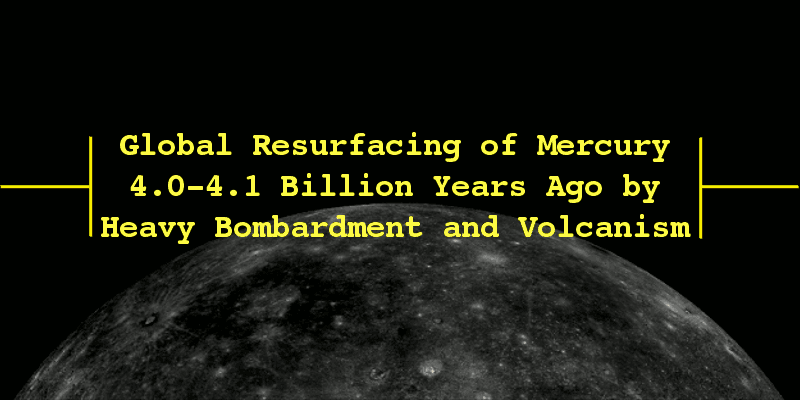
Figure 1. The animation
compares the actual surface of Mercury, as seen by MESSENGER
(left-hand panel: obtained using a publicly available mosaic of
Mercury found here), to the crater areal
density (right-hand panel: number of craters larger than 25 km
averaged over neighbor regions of 300 km in radius). The crater
density is shown in color, ranging from dark blue (minimum) to white
(maximum).
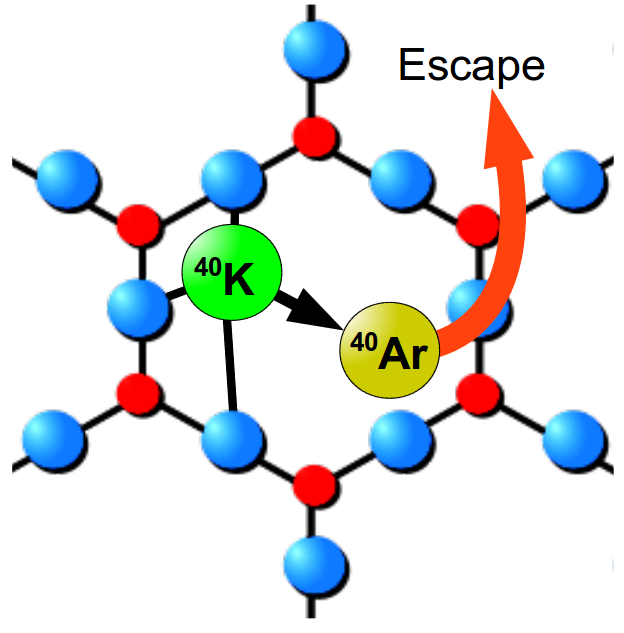
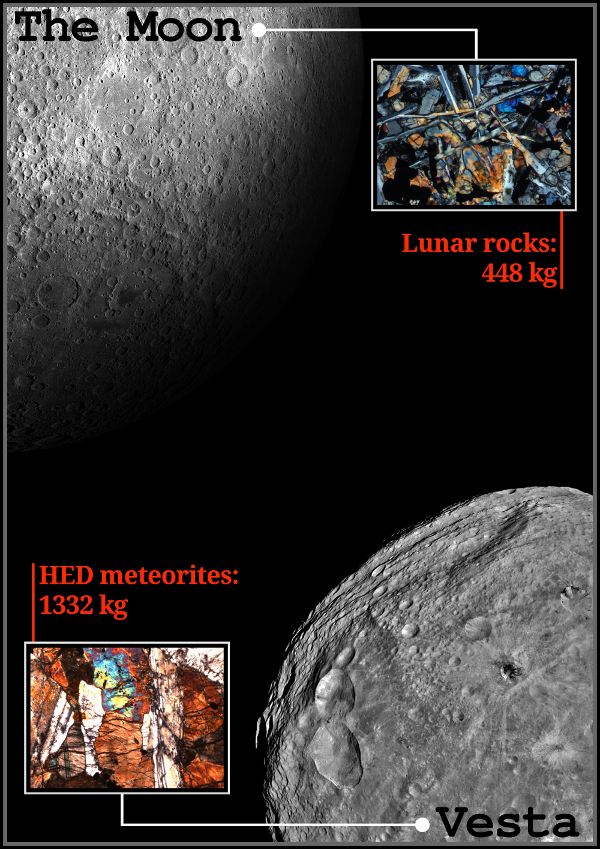
Figure 2. Lunar and Vestan samples.
The new research demonstrates how to use howardite,
eucrite and diogenite (HED) meteorites, that originated from Vesta,
to study the lunar cataclysm. Interestingly, the total mass of
lunar rocks stored in our laboratories is approximately
448 kg. For comparison, HEDs sum up to 1332 kg. Thus, thanks to the new
interpretation of HEDs impact-reset ages, this new work
expanded by about three times the total mass available to study
the lunar cataclysm.
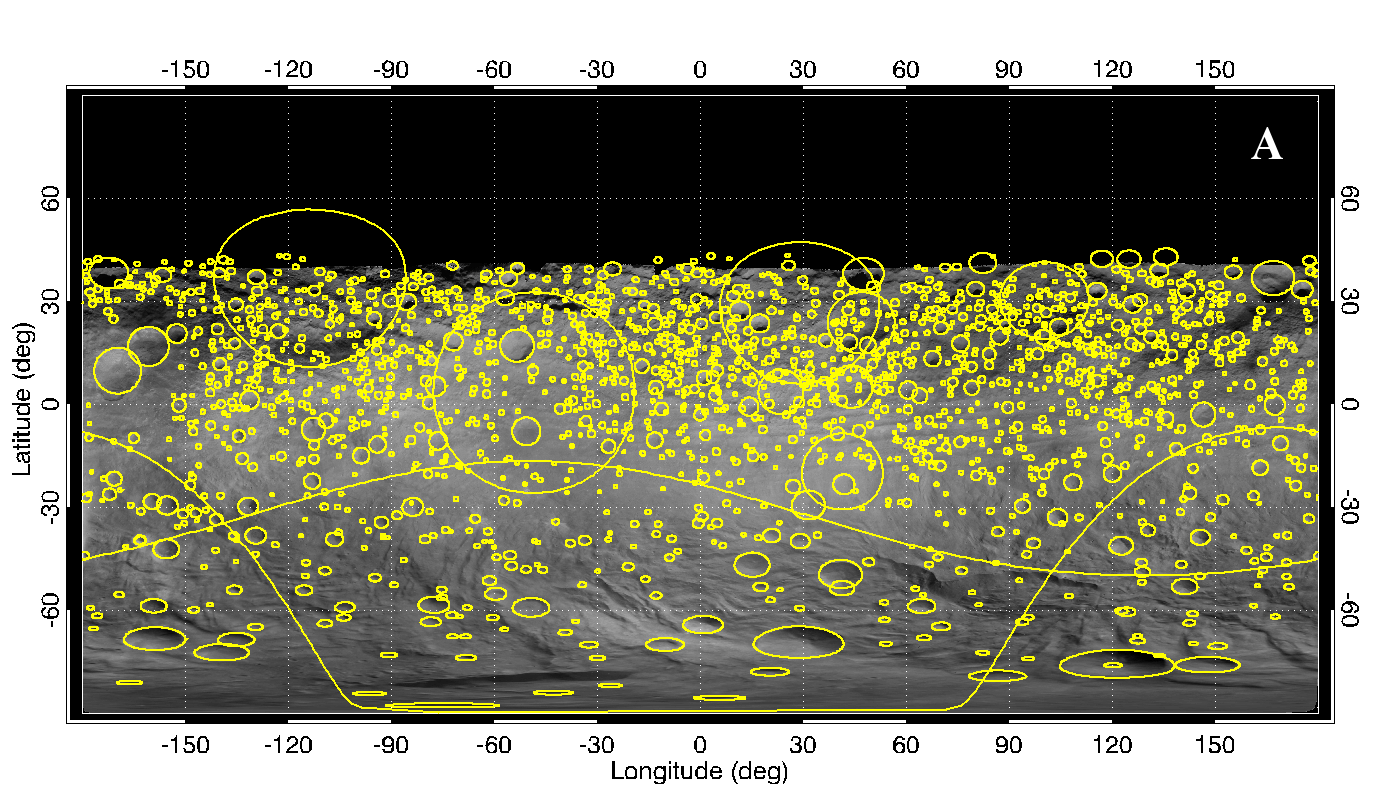
Beside the (remarkable!) fact that Vesta is one of the few asteroids ever reached by a
spacecraft, Vesta is a really unique body for many other reasons.
In particular, I find it absolutely mind-blowing that we do have chips of Vesta
in our meteorite collections. This is truly a striking feature.
Among the ~500,000 kg of extraterrestrial material in our labs, we have
only established genetic links for three objects so far: Vesta, the Moon and
Mars. Among them, Vesta is the farthest from us: ~1.1 astronomical units (~164,557,657 km)
at the closest. Here is picture of a chip from Vesta's deeper crust (a rock type
called diogenite, also common on the Earth) sitting on my desk:
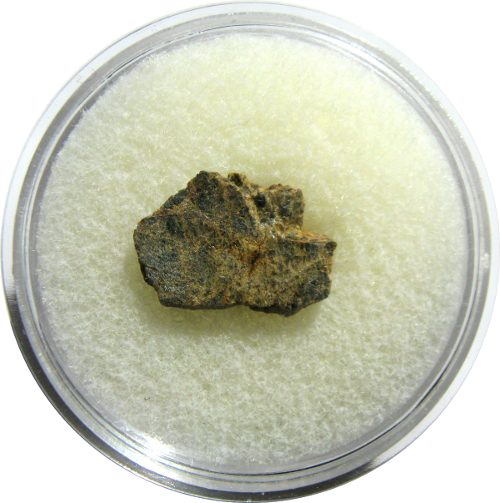
Figure 2. Diogenite "Tatahouine" found in Tunisia.
The parent meteorite fell on June 27, 1931 near the town Foam Tatahouine.
Several fragments (for a total of ~13 kg) were collected afterward.
The meteorite is also known as "Green Meteorite" given its greenish color.
The fragment shown in this picture is about 1 cm wide. In addition to diogenites,
eucrite and howardite (the latter is a mixture of the first two) meteorites are also
thought to come from Vesta.
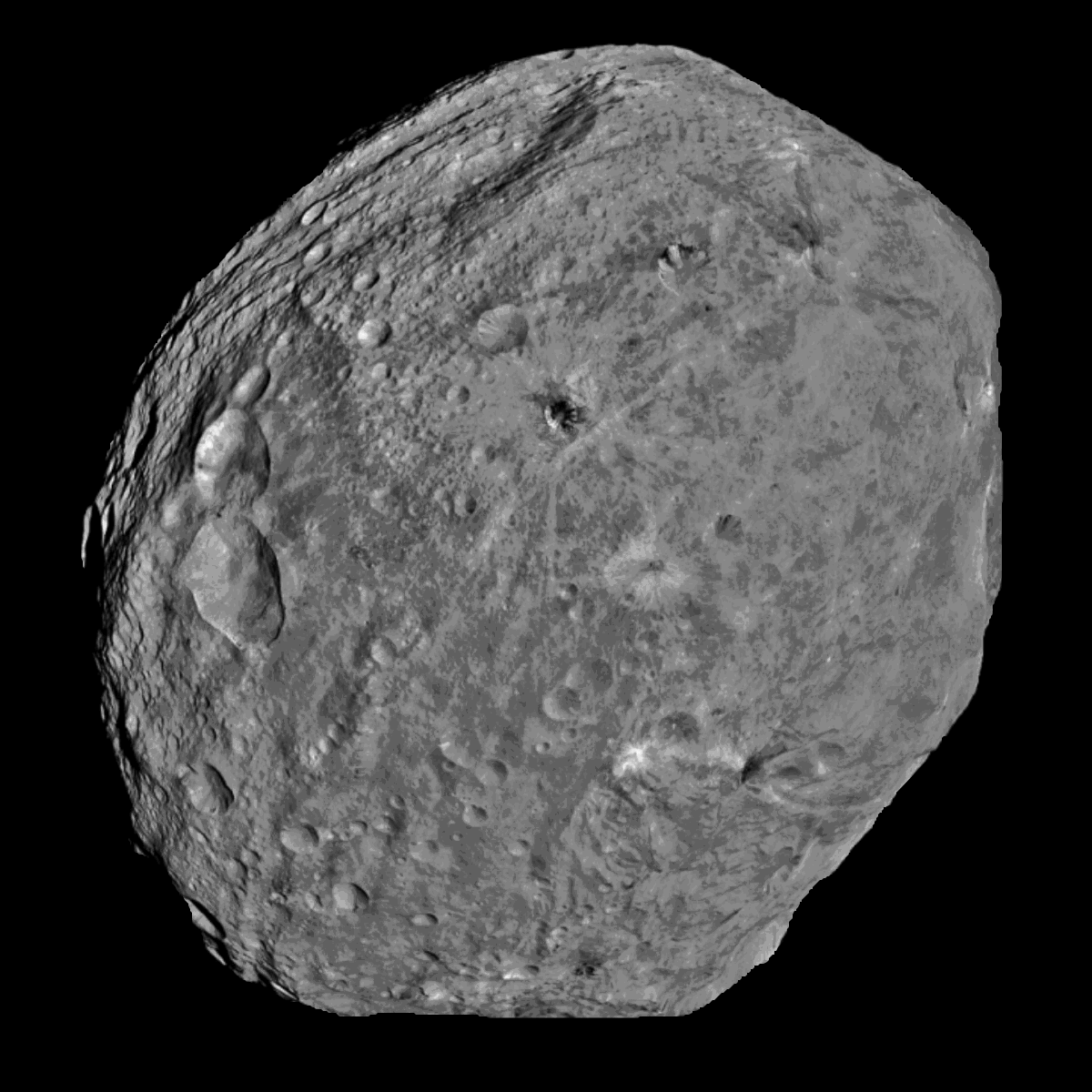
Figure 3. Animation showing the two faces of Vesta.
Well, this is not exactly what Dawn saw at Vesta, but it helps visualizing the two
faces of Vesta (the faces are a representation of the roman god Janus Bifrons
on a coin, ~200 BCE).
Home
Curriculum Vitae
Publications
Fun Stuff
© 2021 Simone Marchi